Jason Schneider
the Camera Collector
Pinkham & Smith: America’s most coveted, costly, and ingenious portrait lenses
Pinkham & Smith: America’s most coveted, costly, and ingenious portrait lenses
A Boston optician balked at copying the Brits, so he used the 1901 version of "aspheric elements" to create an enduring legend!
By Jason Schneider
Unknown to most of today’s photographers, Pinkham & Smith in Boston arguably created America’s most highly sought after and collectible classic lenses – soft focus portrait lenses of a very special ethereal beauty. So, what happens when you have a very loved and rare lens line? Not one, but two attempts to manufacture new versions, both of which also became rare collectibles!
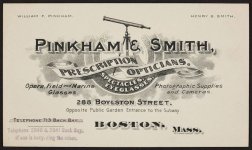
Pinkham & Smith flyer noting range of products sold, including photographic supplies.
By the late 19[SUP]th[/SUP] century Pinkham & Smith Company, located on Boylston St. in Boston, Massachusetts, was already well established as a precision optical company whose primary businesses were dispensing prescription eyeglasses, making lenses for binoculars and telescopes, and manufacturing scientific instruments such as barometric recorders. William Fitz Pinkham and Henry Smith also had an interest in photography and eventually opened a second location, a retail store on Bromfield Street, Boston's “camera row,” which sold a full line of photographic supplies. Frank Peckman (a fine portrait photographer, lab owner, and a big fan of Pinkham & Smith lenses) who extensively researched the long defunct Pinkham & Smith Company, tells the following fascinating story of how the company came to be the most renowned makers of soft-focus lenses in the U.S during the first half of the 20[SUP]th[/SUP] century:
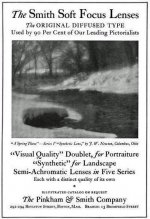
Flyer for various types of Pinkham & Smith soft focus lenses noting 2 branches of the company.
Sometime in 1901, photographer F. Holland Day brought a soft-focus lens made by Dallmeyer (the venerable London-based lens maker) that he’d purchased on a trip to Europe, and asked Harry Smith if he could make a duplicate of it. Whether Mr. Smith was morally opposed to this idea or simply thought he could do a better job is uncertain at this point, but he didn't duplicate the lens. Instead, he created his own formula for a new soft-focus lens, then a novel concept for an American lens manufacture, and went on to produce what is arguably the most acclaimed, coveted, and collected series of soft-focus lenses the world has ever seen. Unlike many other photographic products that have attained a legendary, almost mythical cult status (with prices to match!) Pinkham & Smith lenses truly deliver something unique and unmatched—a distinctive rendition that combines high sharpness and detail rendition, and a signature softness in the highlights and out of focus areas in images shot at the widest apertures. It’s a look that such acclaimed soft-focus lenses as the Leitz/Leica Thambar, the Rodenstock Imagon, and the Dallmeyer Soft Focus cannot duplicate, and it may be due in part to the use of the early 1900s version of (wait for it) “customized aspheric surfaces!”
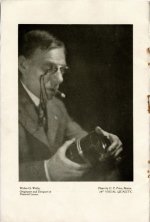
Portrait of Walter G. Wolfe holding Pinkham & Smith lens, shot with a 14-inch "Visual Quality" soft focus lens.
Smith and Walter Wolfe, another Pinkham & Smith employee, would go on to produce several different styles of soft-focus lenses which would become the go-to choices of most U.S. pictorial photographers through the 1910s. The P&S "Visual Quality" lens is widely acclaimed as being their best (probably because it has the least amount of diffusion) and was made from the late teens through the 1920's. In his dogged pursuit of all aspects of the P&S company, Frank Peckman eventually located the son of former company owner, William F. Pinkham, and convinced him that there were legions of photographers who still admired his father's legendary lenses and would be delighted to purchase new ones because it was becoming increasingly difficult to find original examples.
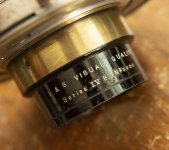
The legendary Pinkham & Smith "Visual Quality" Series IV B lens inspired at least 2 attempts to recreate its "sharp but ethereal" quality.

Image shot with Pinkham & Smith Visual Quality lens has a distinctive "luminous" quality few other soft focus lenses can replicate.
Pekman proposed that they should team up and manufacture a limited-edition lens based on the original lens formula, and since Pinkham's son was now living in Lexington, Massachusetts, the resulting lenses, most probably made in the ‘50s, were engraved with the name of that city. The lens they chose to “duplicate” had been the company’s best seller, the “Visual Quality”14-inch f4.5, which covers 8x10 format used on large studio and field cameras. Exactly who manufactured the new lens, which was dubbed the “Bi-Quality” is uncertain, but though it was assuredly based on the "Visual Quality" lens the "Bi-Quality" does not appear to have the hand-ground elements and surfaces of the original. Also its aperture resembles the type used by Kodak for their own soft-focus lenses. While both the original “Visual Quality” and later “Bi-Quality “lenses deliver gorgeous rendition with that signature combination of sharpness “overlaid” by softness, the vintage “VQ” P&S Boston lenses are unique, each having its own distinctive visual quality due to its individually hand-ground elements, rather like a fine Burgundy having a different nose and palate depending on its vintage. The most noticeable difference is the degree of softness at maximum aperture but there are other more subtle differences as well. The name "Bi-Quality" may be an oblique reference to the fact that the lens can either be used as a soft-focus at wide apertures or as a sharp focusing lens when stopped down. How many of these beauties were produced? Estimates range from a low of 50 to a high in the low hundreds, but evidently “Bi-Quality” lenses are at least as rare, pricey, and collectible as their Pinkham & Smith, Boston predecessors.
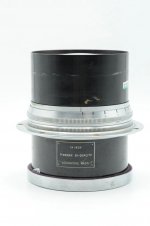
Pinkham & Smith 14-inch "Bi-Quality" lens, side view. Note Lexington, Mass. address on nameplate.
What, aspheric lens elements in 1901! In a way, yes!
The only reason we have a clearer idea of what Pinkham & Smith did to achieve the distinctive rendition that has transformed their soft-focus lenses into cult user-collectibles is that the venerable English firm of Cooke Optics of England decided to make a functional copy to serve the needs of today’s art photographers, many of whom use soft-focus techniques to create impressionistic effects. According to Wikipedia,“The foundation of Cooke Optics can be regarded as the foundation of Taylor,Taylor and Hobson (TTH) in 1886, and the present Cooke Optics can be regarded as the successor of the original Taylor, Taylor and Hobson business.” To cut to the chase, Cooke had been in business for about 120 years when it decided to produce a contemporary version of Pinkham & Smith’s legendary “Visual Quality” Series IV 9-inch f/4.5 lens. So, they paid through the nose like everybody else to acquire a sample, disassembled it and analyzed the curvatures if its elements, the refractive indices of its glass, and its overall design structure. To their astonishment they found that the lens contained elements that had been hand polished to tweak the conventional spherical curves produced by traditional lens grinding techniques—in short one-off, custom ground aspheric elements made over 100 years ago! Here’s the backstory with heartfelt thanks to Mike Collette, founder of Better Light, who posted his Cooke Soft Focus Lens story online:
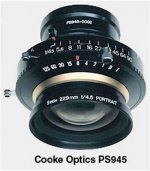
Cooke PS945 soft focus lens is essentially a modern coated version of the Pinkham & Smith "Visual Quality" type IV.
As large-format lens designs improved during the first half of the twentieth century, image sharpness improved as optical aberrations could be better corrected, so some pictorial photographers gravitated toward lenses designed to yield an intentionally “less than perfect” result for their impressionistic images. A series of such lenses was designed by the Boston optics firm of Pinkham & Smith specifically for pictorial photography, one of the most notable being the “Visual Quality” Series IV 9-inch f/4.5, which combined very sharp performance at smaller apertures settings with a wonderful highlight diffusion at wider apertures. This combination of sharpness and softness could be controlled by varying the aperture setting, giving photographers a very interesting tool for controlling the look of the image.
Here’s Cooke’s promotional pitch
“UK-basedCooke Optics (www.cookeoptics.com) has re-created this legendary optical design in their recently introduced PS945 soft-focus lens, complete with the original aspheric elements, but with modern coatings to improve color and reduce internal reflections. These limited-production lenses are more expensive than typical large-format optics but offer some unique options for the discerning photographer. One factor driving price is the relatively large maximum aperture of f-4.5 for a 229mm lens, requiring substantial elements and a Copal 3 shutter. However, examining a few images from this lens quickly renders price secondary to less tangible qualities it offers, quite literally unlike anything one has seen before."
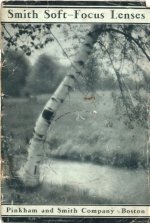
Pinkham & Smith 1928 catalog cover.features an impressionistic landscape image.
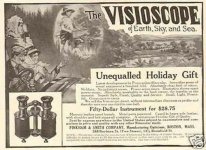
Pinkham & Smith Binoculars Ad: The company, listed here as "Manufacturing Opticians," made prescription eyeglasses and a range of optical devices, including binoculars.
A revealing quote from Cooke’s description of the PS945:
"The original Pinkham & Smith lenses achieve their distinctive soft focus in a manner different from other lenses. Using the traditional glass available at the time, craftsmen hand-corrected multiple surfaces of the lenses to achieve their unique soft-focus look. The introduction of aspherical surfaces gave Pinkham & Smith lenses a higher-order spherical aberration that results (when the lens was used fully open) in an image with both very high resolution and a self-luminescent quality. Cooke has reproduced the unique performance of these hand aspherized lenses using modern design techniques that duplicate this unique soft yet high-resolution performance exactly.”
Regrettably, I haven’t had the opportunity of shooting with either a genuine vintage Pinkham & Smith soft focus lens or a Cooke PS945, but it’s clear that one thing the Cooke near-replica cannot do with standardized modern optical production techniques is to duplicate the individual imaging characteristics of each P&S lens. And while coating is usually a good idea since it minimizes flare and internal reflections it may not be such a great advance when applied to lenses of this type.
For a good overview on the various types of first-generation Pinkham & Smith soft focus lenses, go to Stephen Gandy’s nicely illustrated article by clicking on:
https://www.cameraquest.com/pinkham_...al_quality.htm or copying it into your browser.
Pinkham & Smith: America’s most coveted, costly, and ingenious portrait lenses
A Boston optician balked at copying the Brits, so he used the 1901 version of "aspheric elements" to create an enduring legend!
By Jason Schneider
Unknown to most of today’s photographers, Pinkham & Smith in Boston arguably created America’s most highly sought after and collectible classic lenses – soft focus portrait lenses of a very special ethereal beauty. So, what happens when you have a very loved and rare lens line? Not one, but two attempts to manufacture new versions, both of which also became rare collectibles!

Pinkham & Smith flyer noting range of products sold, including photographic supplies.
By the late 19[SUP]th[/SUP] century Pinkham & Smith Company, located on Boylston St. in Boston, Massachusetts, was already well established as a precision optical company whose primary businesses were dispensing prescription eyeglasses, making lenses for binoculars and telescopes, and manufacturing scientific instruments such as barometric recorders. William Fitz Pinkham and Henry Smith also had an interest in photography and eventually opened a second location, a retail store on Bromfield Street, Boston's “camera row,” which sold a full line of photographic supplies. Frank Peckman (a fine portrait photographer, lab owner, and a big fan of Pinkham & Smith lenses) who extensively researched the long defunct Pinkham & Smith Company, tells the following fascinating story of how the company came to be the most renowned makers of soft-focus lenses in the U.S during the first half of the 20[SUP]th[/SUP] century:

Flyer for various types of Pinkham & Smith soft focus lenses noting 2 branches of the company.
Sometime in 1901, photographer F. Holland Day brought a soft-focus lens made by Dallmeyer (the venerable London-based lens maker) that he’d purchased on a trip to Europe, and asked Harry Smith if he could make a duplicate of it. Whether Mr. Smith was morally opposed to this idea or simply thought he could do a better job is uncertain at this point, but he didn't duplicate the lens. Instead, he created his own formula for a new soft-focus lens, then a novel concept for an American lens manufacture, and went on to produce what is arguably the most acclaimed, coveted, and collected series of soft-focus lenses the world has ever seen. Unlike many other photographic products that have attained a legendary, almost mythical cult status (with prices to match!) Pinkham & Smith lenses truly deliver something unique and unmatched—a distinctive rendition that combines high sharpness and detail rendition, and a signature softness in the highlights and out of focus areas in images shot at the widest apertures. It’s a look that such acclaimed soft-focus lenses as the Leitz/Leica Thambar, the Rodenstock Imagon, and the Dallmeyer Soft Focus cannot duplicate, and it may be due in part to the use of the early 1900s version of (wait for it) “customized aspheric surfaces!”

Portrait of Walter G. Wolfe holding Pinkham & Smith lens, shot with a 14-inch "Visual Quality" soft focus lens.
Smith and Walter Wolfe, another Pinkham & Smith employee, would go on to produce several different styles of soft-focus lenses which would become the go-to choices of most U.S. pictorial photographers through the 1910s. The P&S "Visual Quality" lens is widely acclaimed as being their best (probably because it has the least amount of diffusion) and was made from the late teens through the 1920's. In his dogged pursuit of all aspects of the P&S company, Frank Peckman eventually located the son of former company owner, William F. Pinkham, and convinced him that there were legions of photographers who still admired his father's legendary lenses and would be delighted to purchase new ones because it was becoming increasingly difficult to find original examples.

The legendary Pinkham & Smith "Visual Quality" Series IV B lens inspired at least 2 attempts to recreate its "sharp but ethereal" quality.

Image shot with Pinkham & Smith Visual Quality lens has a distinctive "luminous" quality few other soft focus lenses can replicate.
Pekman proposed that they should team up and manufacture a limited-edition lens based on the original lens formula, and since Pinkham's son was now living in Lexington, Massachusetts, the resulting lenses, most probably made in the ‘50s, were engraved with the name of that city. The lens they chose to “duplicate” had been the company’s best seller, the “Visual Quality”14-inch f4.5, which covers 8x10 format used on large studio and field cameras. Exactly who manufactured the new lens, which was dubbed the “Bi-Quality” is uncertain, but though it was assuredly based on the "Visual Quality" lens the "Bi-Quality" does not appear to have the hand-ground elements and surfaces of the original. Also its aperture resembles the type used by Kodak for their own soft-focus lenses. While both the original “Visual Quality” and later “Bi-Quality “lenses deliver gorgeous rendition with that signature combination of sharpness “overlaid” by softness, the vintage “VQ” P&S Boston lenses are unique, each having its own distinctive visual quality due to its individually hand-ground elements, rather like a fine Burgundy having a different nose and palate depending on its vintage. The most noticeable difference is the degree of softness at maximum aperture but there are other more subtle differences as well. The name "Bi-Quality" may be an oblique reference to the fact that the lens can either be used as a soft-focus at wide apertures or as a sharp focusing lens when stopped down. How many of these beauties were produced? Estimates range from a low of 50 to a high in the low hundreds, but evidently “Bi-Quality” lenses are at least as rare, pricey, and collectible as their Pinkham & Smith, Boston predecessors.

Pinkham & Smith 14-inch "Bi-Quality" lens, side view. Note Lexington, Mass. address on nameplate.
What, aspheric lens elements in 1901! In a way, yes!
The only reason we have a clearer idea of what Pinkham & Smith did to achieve the distinctive rendition that has transformed their soft-focus lenses into cult user-collectibles is that the venerable English firm of Cooke Optics of England decided to make a functional copy to serve the needs of today’s art photographers, many of whom use soft-focus techniques to create impressionistic effects. According to Wikipedia,“The foundation of Cooke Optics can be regarded as the foundation of Taylor,Taylor and Hobson (TTH) in 1886, and the present Cooke Optics can be regarded as the successor of the original Taylor, Taylor and Hobson business.” To cut to the chase, Cooke had been in business for about 120 years when it decided to produce a contemporary version of Pinkham & Smith’s legendary “Visual Quality” Series IV 9-inch f/4.5 lens. So, they paid through the nose like everybody else to acquire a sample, disassembled it and analyzed the curvatures if its elements, the refractive indices of its glass, and its overall design structure. To their astonishment they found that the lens contained elements that had been hand polished to tweak the conventional spherical curves produced by traditional lens grinding techniques—in short one-off, custom ground aspheric elements made over 100 years ago! Here’s the backstory with heartfelt thanks to Mike Collette, founder of Better Light, who posted his Cooke Soft Focus Lens story online:

Cooke PS945 soft focus lens is essentially a modern coated version of the Pinkham & Smith "Visual Quality" type IV.
As large-format lens designs improved during the first half of the twentieth century, image sharpness improved as optical aberrations could be better corrected, so some pictorial photographers gravitated toward lenses designed to yield an intentionally “less than perfect” result for their impressionistic images. A series of such lenses was designed by the Boston optics firm of Pinkham & Smith specifically for pictorial photography, one of the most notable being the “Visual Quality” Series IV 9-inch f/4.5, which combined very sharp performance at smaller apertures settings with a wonderful highlight diffusion at wider apertures. This combination of sharpness and softness could be controlled by varying the aperture setting, giving photographers a very interesting tool for controlling the look of the image.
Here’s Cooke’s promotional pitch
“UK-basedCooke Optics (www.cookeoptics.com) has re-created this legendary optical design in their recently introduced PS945 soft-focus lens, complete with the original aspheric elements, but with modern coatings to improve color and reduce internal reflections. These limited-production lenses are more expensive than typical large-format optics but offer some unique options for the discerning photographer. One factor driving price is the relatively large maximum aperture of f-4.5 for a 229mm lens, requiring substantial elements and a Copal 3 shutter. However, examining a few images from this lens quickly renders price secondary to less tangible qualities it offers, quite literally unlike anything one has seen before."

Pinkham & Smith 1928 catalog cover.features an impressionistic landscape image.

Pinkham & Smith Binoculars Ad: The company, listed here as "Manufacturing Opticians," made prescription eyeglasses and a range of optical devices, including binoculars.
A revealing quote from Cooke’s description of the PS945:
"The original Pinkham & Smith lenses achieve their distinctive soft focus in a manner different from other lenses. Using the traditional glass available at the time, craftsmen hand-corrected multiple surfaces of the lenses to achieve their unique soft-focus look. The introduction of aspherical surfaces gave Pinkham & Smith lenses a higher-order spherical aberration that results (when the lens was used fully open) in an image with both very high resolution and a self-luminescent quality. Cooke has reproduced the unique performance of these hand aspherized lenses using modern design techniques that duplicate this unique soft yet high-resolution performance exactly.”
Regrettably, I haven’t had the opportunity of shooting with either a genuine vintage Pinkham & Smith soft focus lens or a Cooke PS945, but it’s clear that one thing the Cooke near-replica cannot do with standardized modern optical production techniques is to duplicate the individual imaging characteristics of each P&S lens. And while coating is usually a good idea since it minimizes flare and internal reflections it may not be such a great advance when applied to lenses of this type.
For a good overview on the various types of first-generation Pinkham & Smith soft focus lenses, go to Stephen Gandy’s nicely illustrated article by clicking on:
https://www.cameraquest.com/pinkham_...al_quality.htm or copying it into your browser.
boojum
Mentor
Thanks for the extensive and deep article. There is a magic to some lenses and while I cannot buy a P&S and it would not work on a 35mm format camera I am very much appreciative of the Cooke Amotal 2" f/2.0. We cannot know how they compare until they are tested side by side. I'll take your word for the P&S superiority while still loving the Amotal. There is some genius in lensmaking. To achieve real sharpness with an overlay of softness or "glow" is quite a trick. Thanks again.
nikon_sam
Shooter of Film...
I've always been amazed by the image quality of many old photographs...also amazed that these lenses were designed and made by hand and not by some computer.
I've been servicing several Olympus 35-S (1957) cameras with the G. Zuiko 4.2cm 1.8 lens and its because of the lens that I want these cameras to stay alive...the images are sharp but buttery smooth...
The Cooke Optic website is pretty cool...
I've been servicing several Olympus 35-S (1957) cameras with the G. Zuiko 4.2cm 1.8 lens and its because of the lens that I want these cameras to stay alive...the images are sharp but buttery smooth...
The Cooke Optic website is pretty cool...
Emile de Leon
Well-known
Here is mine..


Share:

